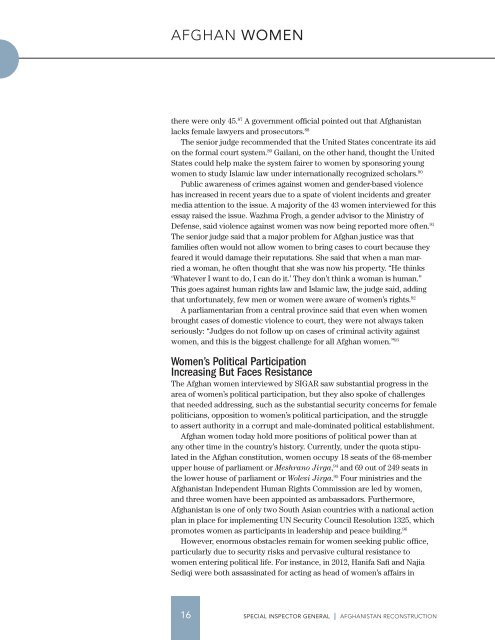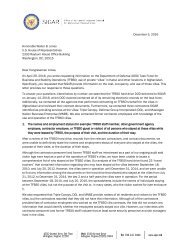SIGAR
2016-10-30qr
2016-10-30qr
Create successful ePaper yourself
Turn your PDF publications into a flip-book with our unique Google optimized e-Paper software.
AFGHAN WOMEN<br />
there were only 45. 87 A government official pointed out that Afghanistan<br />
lacks female lawyers and prosecutors. 88<br />
The senior judge recommended that the United States concentrate its aid<br />
on the formal court system. 89 Gailani, on the other hand, thought the United<br />
States could help make the system fairer to women by sponsoring young<br />
women to study Islamic law under internationally recognized scholars. 90<br />
Public awareness of crimes against women and gender-based violence<br />
has increased in recent years due to a spate of violent incidents and greater<br />
media attention to the issue. A majority of the 43 women interviewed for this<br />
essay raised the issue. Wazhma Frogh, a gender advisor to the Ministry of<br />
Defense, said violence against women was now being reported more often. 91<br />
The senior judge said that a major problem for Afghan justice was that<br />
families often would not allow women to bring cases to court because they<br />
feared it would damage their reputations. She said that when a man married<br />
a woman, he often thought that she was now his property. “He thinks<br />
‘Whatever I want to do, I can do it.’ They don’t think a woman is human.”<br />
This goes against human rights law and Islamic law, the judge said, adding<br />
that unfortunately, few men or women were aware of women’s rights. 92<br />
A parliamentarian from a central province said that even when women<br />
brought cases of domestic violence to court, they were not always taken<br />
seriously: “Judges do not follow up on cases of criminal activity against<br />
women, and this is the biggest challenge for all Afghan women.” 93<br />
Women’s Political Participation<br />
Increasing But Faces Resistance<br />
The Afghan women interviewed by <strong>SIGAR</strong> saw substantial progress in the<br />
area of women’s political participation, but they also spoke of challenges<br />
that needed addressing, such as the substantial security concerns for female<br />
politicians, opposition to women’s political participation, and the struggle<br />
to assert authority in a corrupt and male-dominated political establishment.<br />
Afghan women today hold more positions of political power than at<br />
any other time in the country’s history. Currently, under the quota stipulated<br />
in the Afghan constitution, women occupy 18 seats of the 68-member<br />
upper house of parliament or Meshrano Jirga, 94 and 69 out of 249 seats in<br />
the lower house of parliament or Wolesi Jirga. 95 Four ministries and the<br />
Afghanistan Independent Human Rights Commission are led by women,<br />
and three women have been appointed as ambassadors. Furthermore,<br />
Afghanistan is one of only two South Asian countries with a national action<br />
plan in place for implementing UN Security Council Resolution 1325, which<br />
promotes women as participants in leadership and peace building. 96<br />
However, enormous obstacles remain for women seeking public office,<br />
particularly due to security risks and pervasive cultural resistance to<br />
women entering political life. For instance, in 2012, Hanifa Safi and Najia<br />
Sediqi were both assassinated for acting as head of women’s affairs in<br />
16<br />
SPECIAL INSPECTOR GENERAL I AFGHANISTAN RECONSTRUCTION




